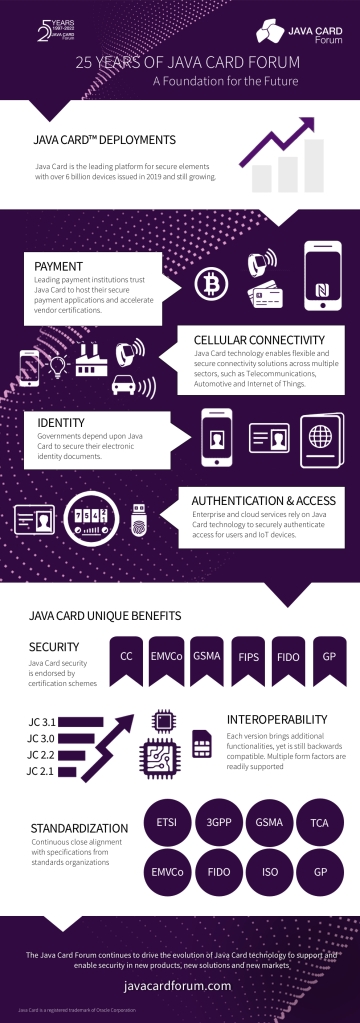As part of the Java Card Forum’s 25 year celebrations in 2022, we asked the Smart Payment Association why the work of the Java Card Forum, and in particular the release of the Java Card 3.1 specification, is key to the evolution of payment security.
By Lorenzo Gaston, Technical Director, Smart payment Association
The IoT use case for card payments and Java Card v3.1 Specifications
IoT is a debated technology in the card payments industry since 2017. Different pilots are ongoing for a series of identified scenarios: Smart home, wearables and intelligent cars, as well as the next generation of petrol stations. Yet they still remain inconclusive. Use cases in these scenarios assume that an IoT device may initiate a purchase and/or a payment on behalf of the end-user. These use cases are not that easy to categorize from a legal perspective. IoT card payments also raise challenges in terms of legal compliance, with requirements for authentication, end-user consent and payment repudiation.
Moreover, IoT systems are cyber-vulnerable and shall be subject to specific design security certification procedures according to the EU Cybersecurity Act and the recent EU Cyber Resilience Act (“The CRA”). It’s still unclear how these EU Acts will impact card payment products implemented in different form factors. The reality is that (1) early compromise of IoT payments would kill the aforementioned uses cases and (2) security vulnerabilities exist in IoT because of the broad level of heterogeneous devices in field, with reduced memory and processing capabilities.
The deployment of IoT systems suffers from a lack of technical standards as well, especially if the payment processing back-office is hosted in the Cloud. These different legal and technical unknowns make the broad adoption of IoT by banks difficult. As a result, the payments card industry, is in a “wait and see” position, until IoT devices reach the level of maturity in terms of security, required to support card-based payment applications.
In this context, SPA can only welcome the effort provided by the Java Card Forum to release the Java Card 3.1 specifications, intended to also enable the development of an open and interoperable application platform for the security of IoT devices. Java Card 3.1 introduces new APIs and updated cryptography functions to address IoT security needs. Java Card 3.1 also allows the development of security services that are portable across a wide range of IoT security hardware. Remote device attestation services as specified by the JC 3.1 will contribute to the early identification of IoT components that have been tampered with. IoT systems will feature a diversity of technical architectures and communication pathways between individual IoT devices, intermediate gateways and back-office payment authorization servers. The new extensible I/O model enables central applications to exchange sensitive data directly with connected IoT devices, over different physical layers and application protocols. In this context, the ability to address and fix individual IoT devices is a core security requirement. If IoT devices support JC 3.1 implementations, the monitoring capability of central banking facilities will be substantially improved.
SPA believes that the publication of JC 3.1 represents a key step forward to increase trust in IoT technology by the financial community. With that in mind, SPA draws your attention to the fact that PCI-SSC has just released its first bulletin including security considerations when deploying IoT in card payments. It includes with a definition for IoT devices, not specific to payments and more interestingly it provides a list of 10 “high level” security controls IoT “secure” devices should meet. These 10 security controls are mapped onto specific detailed requirements in a US ANSI/CTA 2088-A “Baseline Cybersecurity Standard for Devices and Systems”. Things are starting to move in the payments industry with respect to IoT technology and JC 3.1 appears as a timely enabler for this positive market evolution.
Is there a case for the implementation of Post-Quantum payment cards using JC v3.1 specifications?
Cryptographic extensions proposed by Java Card 3.1 significantly increases the potential for the card to provide security services to payment systems. Card payment systems are in the process of evaluating migration patterns towards stronger cryptography. A new generation of chips supporting more efficient Java Virtual Machines will allow the usage of more complex cryptographic algorithms. The challenges for the migration differ:
- Migration to AES 256 bit will protect symmetric cryptography for card payment systems against quantum cryptanalysis. Given that, symmetric post quantum cryptographic algorithms are defined and standardized and can already be adopted. Domestic and International Card Schemes are already in the process of migrating from TDES to AES. JC v3.1 supports new cipher modes for AES and updated cryptographic packages to handle symmetric keys as trusted objects
- The pathway for stronger asymmetric cryptography is more complex and different, as there are currently no post quantum cryptographic algorithms for the asymmetric use case defined or available. Furthermore, some of the proposed algorithms impose some challenges to current secure elements that implement Java Card technology, in terms of performance and available memory space. Within the payment industry, migration strategies are under discussion. SPA defends the use case of offline payment authentication using ECC according to:
- The EMVCo recently released specifications: EMV Specification Bulletin 243 for contact cards and ECC C-8 Contactless Kernel specification for contactless payments and,
- Backwards compatibility with existing RSA-based products
Therefore, in the short term, SPA outlines the need to specify methods for the ECC algorithms for both the EMV contact and EMV C-8 contactless specifications.
In the medium term, hybrid cryptographic payment cards and terminals will support classical and post-quantum public key mechanisms in addition to AES. Because of the traditional long term migration periods for devices in card payment systems, it matters that future versions of the Java Card API include methods for access of payment applets to Post-Quantum cryptographic algorithms, such as those under standardization by US NIST after the conclusion of the 3rd round in the NIST selection contest.
What new regulated payment instruments could benefit from JC v3.1 extended functionalities?
The current payment landscape is dominated by cash and card payments for retail and person-to person transactions. For online payments, there are additional methods established, mostly based on direct credit transfer. New methods, such as instant payment or central bank digital currencies are on the horizon. Regulations, such as PSD2 for example, and the planned PSD3 from the EU, enforce higher security for all of these payment methods by mandating strong customer authentication (SCA). They also intend to open payment methods to independent players, so-called Payment Initiation Service Providers (PISPs) and Account Servicing Payment Service Providers (ASPSPs).
Java Card technology is well suited to support these new payment instruments and comply with SCA, by implementing the legally defined authentication factor “something you own”. This can typically be a Smart Card, a mobile phone with an embedded Secure Element or (embedded) UICC, or other form factors. When these secure elements are based on JC 3.1 technology, they offer a simple possibility to add on these platforms multiple payment applications for different payment systems, which can, for instance, share essential confidential personal authentication data, such as the PIN code. As a further extension, it can also provide biometrics as an on-device cardholder verification method supporting the authentication factor “what you are”. Finally, the highly standardized JCF technology also allows a simple usage of these applications on different product platforms, without the need to change the application in the form of a Java Card applet itself.
State of the global market for payment cards and how SPA is advocating the use of card technology as the preferred retail payment instrument
The Smart Payment Association (SPA) includes the leading payment card vendors (AUSTRIACARD, IDEMIA, G+D, Thales DIS) and silicon manufacturers (Infineon, ST). SPA is organized in eight different WG’s addressing key domains of the payments card industry. Four of these WGs are of a technical nature and support the activity of SPA in standards bodies (EMVCo, PCI-SCC, European Cards Stakeholders Group (ECSG), European Payments Council (EPC)), payments industry groups led by European Payment Regulators (i.e. Payment Systems Market Expert Group – PSMEG), as well as the close monitoring of the evolving regulatory context for payments and the corresponding security certification framework (e.g., ENISA). SPA is recognized by its partners by our high level of commitment and contribution.
The smart payment cards market continues growing:
- 2.63 billion smart payment cards and modules were delivered worldwide in 2021 by SPA Members and Advisory Council participants
- Contactless cards accounted for 76% of all shipments, hitting the 2 billion threshold for the first time.
- Circa 100 million next-generation eco-friendly smart payment cards delivered globally
** The views expressed in this article are solely those of the author listed and do not necessarily reflect the views of the Java Card Forum, its Members or Oracle. **












You must be logged in to post a comment.